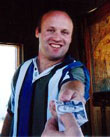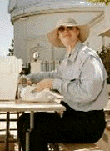|
|
 
|
|
Author
|
Topic: Thread-Up Diagrams
|
Richard Quesnelle
Film Handler
Posts: 67
From: Penetang, Ontario, Canada
Registered: Mar 2000
|
 posted 06-23-2000 06:39 AM
posted 06-23-2000 06:39 AM




I was just curious if it would be possible that in the manuals section, we could have pictures or diagrams of the projector (and/or soundhead)threading procedure because I have never seen one in the manuals. I was just being curious as I would like to learn the threading procedures for the most common projector/soundhead set-up so I could possibly get another projectionist job. Also, I would like to see loop size to determine if my loops are to big (Century C/CC). If anyone has any, please send them to Brad.
Thanks Reg
| IP: Logged
|
|
|
|
|
|
John Walsh
Film God

Posts: 2490
From: Connecticut, USA, Earth, Milky Way
Registered: Oct 1999
|
 posted 06-23-2000 02:22 PM
posted 06-23-2000 02:22 PM




A Century C and Brenkert BX60? I thought you meant real projectors!  Only kidding, please put that gun away! Only kidding, please put that gun away!Have you looked at the other Century or Brenkert manuals? Maybe the threading diagram for those are shown, and are close enough to your projectors to use? I have noticed that the documentation in projector manuals regarding use and threading have always been poor (well, except for a AA-II.) It's like they expect you to already know lots of other stuff. But, you might try to figure it out yourself; now, I don't mean that rudely... I mean try to see exactly where the film has to go to run right. For example, on any projector, we know that the optical sound is 18 frames ahead of the picture. So, get a length of scrap film, put a mark in the center of one frame. Count 18 frames ahead, and put a mark in the center of that frame. Then, thread the projector, placing one mark at the aperture and the other centered with the sound lens. For a little more accuracy, manually turn the motor over to place the shutter at the aperture during the "dwell" period before threading (where the shutter is blocking the light, but the intermittent is not pulling down the film.) On some projectors like Centurys (I can't remember about Brenkerts) there's an intermediate drive sprocket in between the sound head and the intermittent. Now, you need to know what part of the film to put on that sprocket. You probably know that some projectors like Centurys usually require you to put (or pull) one sprocket hole of tension on the film as it goes around the impedence roller (sound drum.) So if you pull one sprocket hole up and lock it in, (or do what ever that particular sound head mfg. wants) the loop under the intermittent is now set. If there isn't an intermediate drive sprocket between the sound head and the intermittent, (like a Cinemecannica or a Norelco) that part is done. It already is at the correct distance. With the scrap film threaded like this, turn the framing knob about 1 full frame each way, (simulating correcting an out-of-frame) and advance the film a little each time. Verify it does not hit anything. Do the same kind of thing for the loop above the gate. The film should have a gentle curve as it "exits" the feed sprocket, regardless of the framing knob's position. Of course, if you have a "before the gate" digital reader, the installer should have told you what that (reader to gate) distance is. At a very long, narrow theater I worked at, we would advance the sound by a few sprocket holes, so people in the rear of the theater would hear the sound of an on-screen explosion at about the same time as it appeared. If we didn't, there would be a few millisecond delay. Now, I don't know how much you know about projection, so I'm sorry if I said a bunch of stuff you already knew. But, this is what I show people if they are going to work at another theater, but don't know what equipment is there.
| IP: Logged
|
|
|
|
|
|
Ken Layton
Phenomenal Film Handler

Posts: 1452
From: Olympia, Wash. USA
Registered: Sep 1999
|
 posted 06-24-2000 12:17 PM
posted 06-24-2000 12:17 PM




Brad:The Brenkert BX-100 manual has a threading diagram on page 12 (original manual page number, not the PDF page number). The Century MSC-TA manual dated 4-93 has a threading diagram on page 9. This could be applied to any Century machine.
| IP: Logged
|
|
|
|
|
|
|
|
|
|
|
|
|
|
|
|
|
|
All times are Central (GMT -6:00)
|
|
Powered by Infopop Corporation
UBB.classicTM
6.3.1.2
The Film-Tech Forums are designed for various members related to the cinema industry to express their opinions, viewpoints and testimonials on various products, services and events based upon speculation, personal knowledge and factual information through use, therefore all views represented here allow no liability upon the publishers of this web site and the owners of said views assume no liability for any ill will resulting from these postings. The posts made here are for educational as well as entertainment purposes and as such anyone viewing this portion of the website must accept these views as statements of the author of that opinion
and agrees to release the authors from any and all liability.
|

 Home
Home
 Products
Products
 Store
Store
 Forum
Forum
 Warehouse
Warehouse
 Contact Us
Contact Us




 Printer-friendly view of this topic
Printer-friendly view of this topic





 Only kidding, please put that gun away!
Only kidding, please put that gun away!










